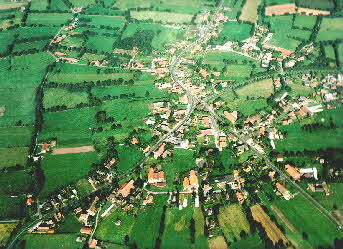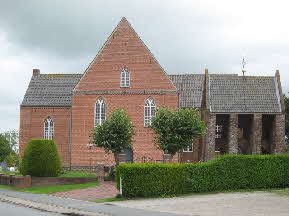|

On the occasion of the Strackholt village festival in 1980, the Chamber of Commerce published a little book, the foreword of which I would like to repeat.
Not unjustly Strackholt is described as "a village from the gray pre-historic times”. When you consider that the church had already been built in the 13th century, a relative large settlement must have been present at this time. You can imagine that here where we live and work today, already 1,000 years ago - -perhaps earlier - -people settled down here. How might it have looked here when the first settlers built their houses, worked their fields and went hunting? It is unfortunate that we know so little from this period. But also the later centuries have their history up to our times. Much is known from the previous centuries from church records, chronicles and other areas. Think about the history of the church and windmills. From land registry documents we can follow the settlement of Höchte and Süddhörn.
But the people also had their history; the Quade Foelke and the cursed Biggenboom (Pig Tree) are alive and well in many stories.
In the second half of the 19th century, conditions in Germany were very critical, both economically and politically in a social respect. Many people heard of the favorable conditions in the United States and emigrated. Many from Strackholt and its Moor colony followed the call of freedom and still more followed these when they read the enthusiastic letters of the emigrants about the unlimited possibilities in their new home.
On March 14, 1874, emigrants from Strackholt and Vossbarg (among others, Meints, Rossmueller, Zimmermann, Schone and Remmers were all related to each other, except Remmers) and founded the Zion Evangelical Lutheran Church in Gage County, Nebraska. This congregation was popularly known as the "Hanover Church". In 1881 Christian Janssen Meints, a carpenter (who was born in Strackholt) built the first church and probably also the additional bell tower in 1898.
In 1999 the congration celebrated its 125th anniversary. People in Strackholt were aware of this and Pastor Moritz sent a letter of congratulations from the "Mother Church" and included a little book of pictures of the Strackholter Church and congregation.
The Saint Barbara Church with bell tower in Strackholt.
 The Bible says, "A thousand years are like one day to you. The Strackholter Church is not 1,000 years old, but certainly 700 years old. It remains in the darkness of history who the people were who set this sign of christianity in a pre-historical landscape. Was it monks who wanted to give the inhabitants a place where they could gather together to hear the word of God? Was it a chieftain who wanted to build a monument for himself? The Bible says, "A thousand years are like one day to you. The Strackholter Church is not 1,000 years old, but certainly 700 years old. It remains in the darkness of history who the people were who set this sign of christianity in a pre-historical landscape. Was it monks who wanted to give the inhabitants a place where they could gather together to hear the word of God? Was it a chieftain who wanted to build a monument for himself?
The bricks for the church had to have been fired in the so-called field distillery.The bell tower next to the church was probably erected with the church or shortly thereafter.
During the course of the Reformation, Ostfriesland became Lutheran. The names of the ministers since 1544 are known. The name of the first minister in 1544 was Johann Strackholt, probably the derivation of the name of the area. The church was magnificently furnished with lovely pictures and a wonderfully artistic baptismal font. One of these was preserved. Much fell victim to renovation work like the mural paintings from pre-reformation times.
The church became too small for the congration and in two stages, 1853 and 1883, was extended into a cross shape. It was offically opened on August 23, 1883.
Directly next to and around the church is the old cemetery, probably as old as the church itself. This church has survived for centuries and has been the center point of the town. In war and troubling times of the last century it was certainly the place of refuge for the threatened inhabitants. It is not only a symbol of the advanced architecture of that time, but also an example of the deep respect which the people of this region have given to the christian ideas.
Let us hope that the bells of Saint Barbara Church will call many more generations to the church service as they have done for centuries.
(German text by Johann Eilers, Strackholt. Translated with the kind permission of the author.)
More on St. Barbara church
|